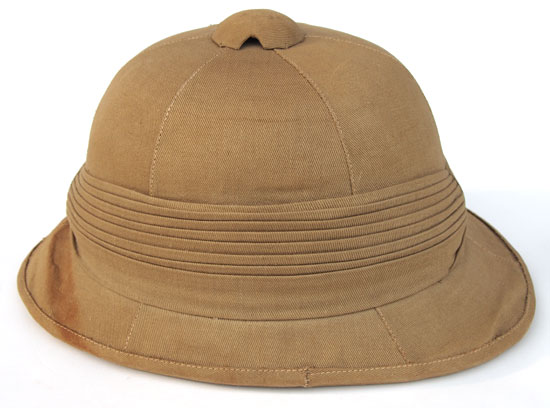 The story of the Wolseley helmet is well documented, but occasionally even we come across something a little different. In this case it is a helmet that has the basic shape of a Wolseley and at first glance could possibly be dismissed as a “child’s helmet.”
The story of the Wolseley helmet is well documented, but occasionally even we come across something a little different. In this case it is a helmet that has the basic shape of a Wolseley and at first glance could possibly be dismissed as a “child’s helmet.”
The story gets interesting however. This helmet, which is a bit of a cross between a Wolseley and a polo style helmet, was apparently made in India. Moreover, while we have noted that the English helmet makers principally worked in cork with the Wolseley – with straw and felt also serving when there were shortages of cork – this Wolseley style helmet is made of sola pith!
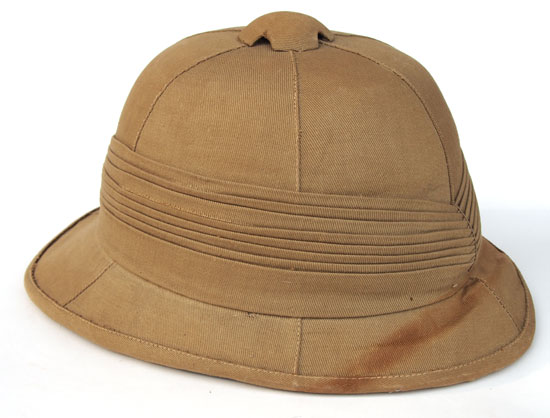 This “Wolseley” – if that is the correct term for it – came from a militaria dealer in Arizona but no other information is known. It features the six panels that we’d expect to see in a Wolesley helmet along with a well-wrapped puggaree.
This “Wolseley” – if that is the correct term for it – came from a militaria dealer in Arizona but no other information is known. It features the six panels that we’d expect to see in a Wolesley helmet along with a well-wrapped puggaree.
The helmet was produced in khaki, suggesting it could have been meant as a private purchase helmet for a military officer. Perhaps it was a custom order by an officer who wanted the look of a Wolseley rather than the Cawnpore, Bombay Bowler or other “Indian” patterns that were made in the sub-continent. One can only speculate in this regard however.
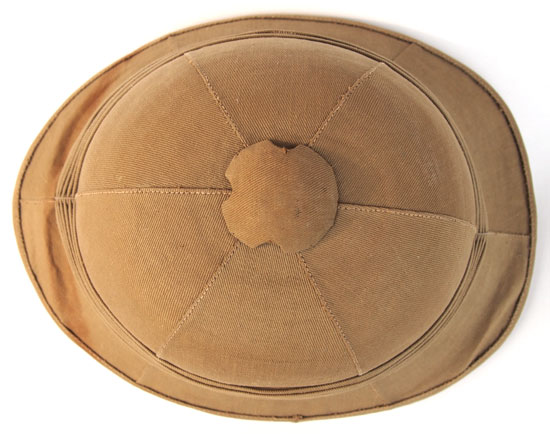 As noted in the photo above the helmet doesn’t have quite the flared out brim of a true Wolseley and the overall size of the helmet is somewhat smaller. It was for this reason that the idea that perhaps it was a child’s helmet was a considered. While the profile of the helmet is somewhat small, it would actually fit a fairly large size head, thus suggesting it was in fact for an adult.
As noted in the photo above the helmet doesn’t have quite the flared out brim of a true Wolseley and the overall size of the helmet is somewhat smaller. It was for this reason that the idea that perhaps it was a child’s helmet was a considered. While the profile of the helmet is somewhat small, it would actually fit a fairly large size head, thus suggesting it was in fact for an adult.
The design is far different from the helmets that were marketed to women in the inter-war period so it is unlikely that it was intended for the fairer sex however. Despite the smaller profile it still seems to evoke a military styled appearance.
The size is actually close to the South African and British style “polo” pattern sun helmets that were introduced in the inter-war periods and used by the South African Army – and to a lesser extent pressed into service and issued to various troops such as the Ethiopian Army in its efforts to liberate its homeland.
While it is possible that the helmet could be have been designed as a custom polo helmet, this is unlikely given that the sola pith construction would likely not be durable enough for use in the sport.
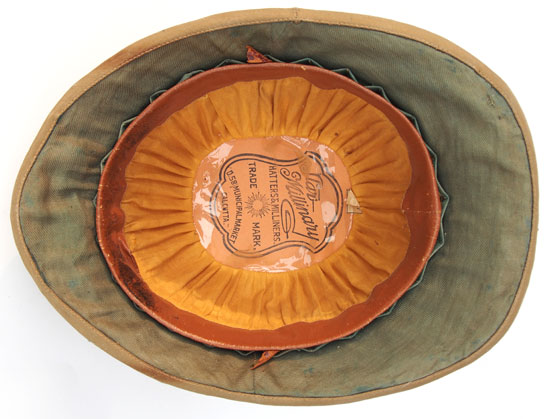 The interior is certainly curious as well, and here the helmet does resemble the typical early style Wolseley with the corrugated buckram to hold the liner in place. The underside of the brim is in green fabric, which is commonly seen in the Wolseley pattern. The liner features a leather cover band over straw – common in Indian pattern helmets, but less common in the Wolseley.
The interior is certainly curious as well, and here the helmet does resemble the typical early style Wolseley with the corrugated buckram to hold the liner in place. The underside of the brim is in green fabric, which is commonly seen in the Wolseley pattern. The liner features a leather cover band over straw – common in Indian pattern helmets, but less common in the Wolseley.
Truly in this regard the helmet is a unique hybrid.
What makes the helmet most interesting is that it is made of sola pith, which is to be expected given its Indian origins. As noted the Wolseley was made of cork, likely imported from Portugal, while ersatz materials such as straw and felt were used when there were shortages. It should be noted that most polo style helmets were made of cork and were likely treated with a resin to increase the strength of the shell. This helmet’s materials remain somewhat soft and spongy given that this helmet is likely 70 plus years old.
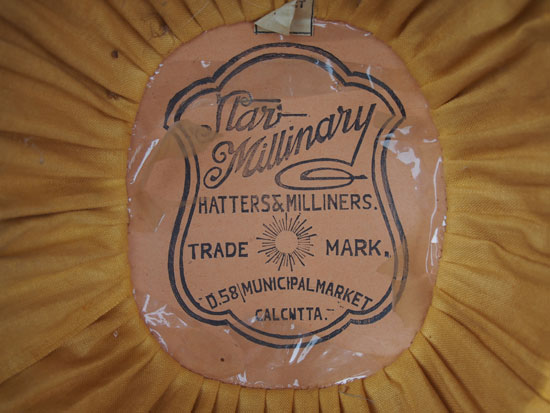 The only real clue is that the helmet was sold – if not actually made – in Caluctta. Based on the seller/maker label inside the helmet was either made and/or sold at the municipal market, which we can take to suggest that was the city’s market in Dalhousie Square. Its origins date to the 1870s and it became a popular destination for affluent colonials from all over India.
The only real clue is that the helmet was sold – if not actually made – in Caluctta. Based on the seller/maker label inside the helmet was either made and/or sold at the municipal market, which we can take to suggest that was the city’s market in Dalhousie Square. Its origins date to the 1870s and it became a popular destination for affluent colonials from all over India.
The market was officially renamed the Sir Stuart Hogg Market in 1903 – and this was later shortened to the Hogg Market. It remained a popular shopping destination until the outbreak of World War II.
Finally, it should be remembered that Calcutta – today Kolkata – is home to Fort William. This is actually two forts – the old Fort William, which was used as a customs house from 1766, and the new fort that served as the command for the British Army in the city. Given the size of the British forces in India throughout the interwar era it is not difficult to believe that many Indian hat and helmet makers went to great lengths to satisfy their customers.
This mystery helmet could be just a clue to how far those hatters went in the name of satisfying the customer’s custom orders
Peter Suciu
August 2015
